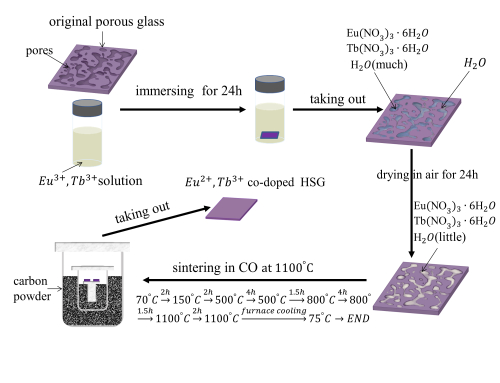Recently, Shanghai Institute of Optics and Fine Mechanics (SIOM) has investigated the effect of Al3+ on the spectroscopic properties of Eu2+- and Tb3+-doped high silica glass. The study has been published in Ceramic International on July 1, 2021.
Al3+ has always been considered as a dispersant of rare-earth ions in the glass, which can effectively inhibit the clusters of rare earth ions and improve the luminescence efficiency of rare earth ions. At the same time, Al3+ is also beneficial for reducing Eu3+ to Eu2+ in Eu2+/Al3+ co-doped high silica glasses. However, the effect of Al3+ on the energy transfer between rare earth ions is rarely reported.
In this work, Eu2+/Al3+-, Eu2+/Tb3+-, and Eu2+/Tb3+/Al3+-doped high silica glasses were prepared by in-situ preparation and heat treatment methods. Due to the addition of Al3+, Eu2+ and Tb3+ ions are dispersed, which counteracts the strong dipole-dipole interaction in high silica glasses and makes the energy transfer weaken or even disappear. The samples show different luminescence phenomena. It is worth noting that the luminescent intensity of Eu2+ at 430 nm is increased by 400 times when Al3+ is at the optimum addition.
Conversely, a significant Eu2+→Tb3+ energy-transfer phenomenon was observed in the Eu2+- and Tb3+-double-doped glasses, and the energy-transfer efficiency reached 66.9%. However, the Al3+ ions strongly inhibited the Eu2+→Tb3+energy transfer, and the efficiency was reduced to 7.2%.
This work was supported by the National Natural Science Foundation of China.

Fig. 1. Schematic of the preparation process. (Image by SIOM)

Fig. 2. (a) Emission spectra of the Eu2+/Tb3+ co-doped high silica glass.
(b) Emission spectra of the Eu2+/Tb3+/Al3+ triple-doped high silica glass.
(c) The fluorescence decay lifetime of Eu2+/Tb3+ co-doped high silica glass at 452 nm;
(d) The fluorescence decay lifetime of Eu2+/Tb3+/Al3+ triple-doped high silica glass at 452 nm. (Image by SIOM)
Article website:
https://doi.org/10.1016/j.ceramint.2021.03.118
Contact:
WU Xiufeng
General Administrative Office
Shanghai Institute of Optics and Fine Mechanics, CAS
Email: xfwu@siom.ac.cn
Web: http://english.siom.cas.cn/